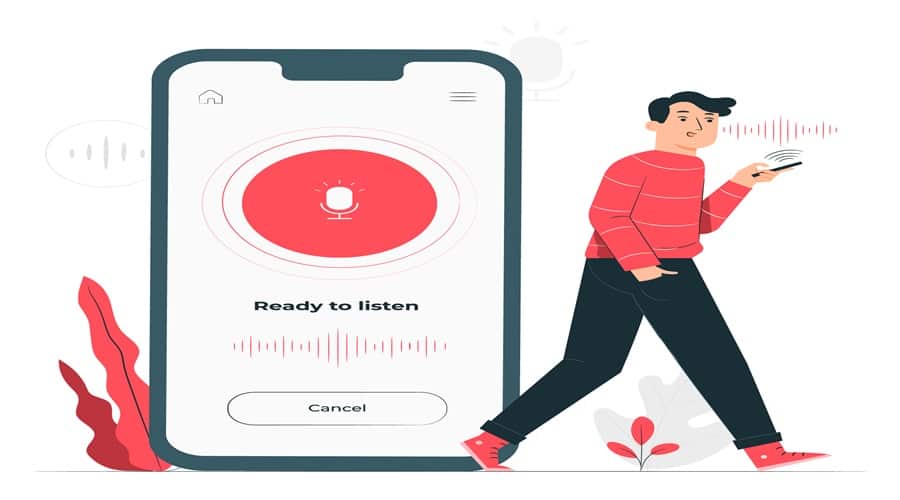
Voice-to-Text Software: Transform Audio into Written Words
In today’s fast-paced digital world, efficiency and productivity are paramount. Voice-to-text software has emerged as a game-changing technology, empowering users to transcribe spoken words into written text with incredible speed and accuracy. Whether you’re a professional writer, a student, or a business professional, this innovative solution can streamline your workflow and unlock new productivity levels.
What is Voice-to-Text Software?
Voice-to-textual content software, or speech popularity software programs, converts spoken words into written text in real-time. It uses superior algorithms and devices getting to know to interpret and transcribe speech, allowing users to dictate textual content fingers-free. This technology has revolutionized how we interact with computer systems and has become an essential tool for many programs.
Benefits of Voice-to-Text Software
Increased Efficiency:
With voice-to-text software, users may rapidly and accurately translate spoken words into written text, saving much time and effort compared to manual typing. Professionals, students, journalists, authors, and others who must produce large amounts of text would benefit from this increased efficiency.
Improved Productivity:
Voice-to-text software eliminates the necessity for manual typing, allowing users to concentrate more on creating ideas and content than on the intricacies of typing. Users can record ideas and thoughts in real-time without being limited by typing speed, increasing productivity and creativity.
Accessibility:
Voice-to-text software allows people with physical restrictions or disabilities that could make it difficult for them to type to access digital content. This technology encourages inclusion and allows people with mobility disabilities to communicate more successfully in digital contexts by allowing users to dictate text using their voice.
Hands-Free Operation:
Voice-to-text software enables hands-free operation, allowing users to dictate text while performing other tasks or activities, such as driving, cooking, or exercising. This hands-free capability enhances multitasking and allows users to stay productive even when their hands are occupied.
Reduced Strain and Fatigue:
Long-term typing can cause strain and weariness in the fingers, wrists, and hands. By enabling users to dictate text using their voice, voice-to-text software lowers the risk of repetitive strain injuries (RSIs) linked to typing and relieves physical strain and weariness.
Accuracy and Precision:
Advancements in voice recognition technology have significantly improved the accuracy and precision of speech-to-text software. With the use of contemporary voice-to-text algorithms, users with various accents, dialects, or speech patterns can produce very accurate spoken word transcriptions into written text.
Language Support:
Voice-to-text software supports multiple languages and dialects, allowing users to transcribe text in their preferred language easily. This language support enhances communication and collaboration across diverse linguistic communities, facilitating global connectivity and information exchange.
Top Features to Look for in Voice-to-Text Software
Several key features can significantly enhance voice-to-text software’s usability and effectiveness. Here are the top features to look for:
Accuracy and Reliability:
One key feature of voice-to-text software is its accuracy in converting spoken words into written text. Look for software that uses cutting-edge speech recognition technology to guarantee accurate and dependable transcription, even for users with different accents, dialects, or speech patterns.
Multi-Language Support:
Select software that enables users to easily transcribe text in their favorite language by supporting various languages and dialects. This function improves adaptability and serves users with different language backgrounds.
Real-Time Transcription:
Thanks to real-time transcription features, users can observe the instantaneous conversion of their spoken words into printed text while speaking. This function is especially helpful for people who prefer to check their dictation while they speak or for situations that call for instant feedback.
Customization and Personalization:
Seek software that allows customization so that users can personalize their transcription experience. This can entail modifying the language models, punctuation preferences, voice recognition sensitivity, and transcription speed.
Editing and Correction Tools:
Choose software that provides robust editing and correction tools to refine the transcribed text and make corrections as needed. Features such as spell check, grammar check, autocorrect, and text formatting options can help users polish their transcriptions and improve overall accuracy.
Integration with Productivity Tools:
Consider software that integrates seamlessly with productivity tools and platforms commonly used for document creation and management. Integration with word processors, email clients, note-taking apps, and cloud storage services facilitates streamlined workflows and efficient document management.
Compatibility Across Devices:
Select software with various hardware and operating systems, such as tablets, smartphones, laptops, and desktop PCs. This guarantees adaptability and accessibility, enabling users to dictate text on their preferred device and from any location.
Voice Commands and Shortcuts:
Look for software that supports voice commands and shortcuts to perform common tasks and navigation actions hands-free. Voice commands can include inserting punctuation, starting a new paragraph, or formatting text, enhancing user convenience and efficiency.
Offline Mode:
Consider software that offers an offline mode, allowing users to transcribe voice input without an internet connection. This feature is useful for users who need to dictate text in environments where internet access may be limited or unavailable.
Security and Privacy Features:
Set software security and privacy as a top priority to safeguard confidential voice recordings and transcribed text from illegal access or data breaches. Pay attention to secure data storage, end-to-end encryption, and adherence to data protection laws.
Popular Voice-to-Text Software Solutions
Dragon NaturallySpeaking

Nuance Communications’ Dragon NaturallySpeaking is a well-known speech recognition program that accurately records spoken words in written language. It provides smooth integration with a range of apps and sophisticated customization options.
Pros:
High accuracy, advanced customization, seamless integration.
Cons:
It can be expensive for some users to require training for optimal performance.
Services Provided:
Real-time transcription, voice commands, and customization features.
Pricing Package:
Various pricing plans are available depending on the edition and features.
Google Speech Recognition
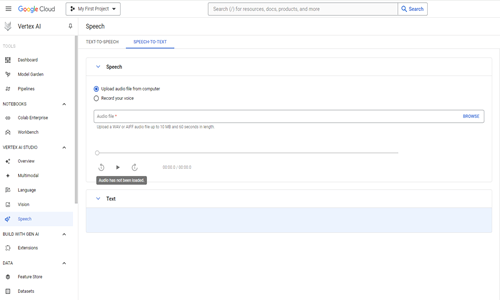
Google Speech Recognition is a cloud-based service that accurately translates spoken words into text. It offers real-time transcription capabilities and supports several languages.
Pros:
Accurate transcription, multiple language support, real-time transcription.
Cons:
Limited customization options, requires internet connection.
Services Provided:
Real-time transcription, multiple language support.
Pricing Package:
Pay-as-you-go pricing based on usage.
Apple Dictation
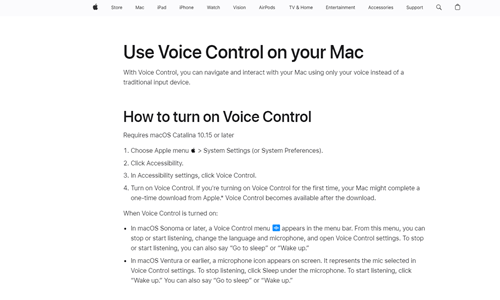
Apple Dictation is a built-in feature for MacOS and iOS devices. It allows users to transcribe spoken words into written text accurately and efficiently. It seamlessly integrates with Apple’s ecosystem of devices and services.
Pros:
Seamless integration, accuracy, efficiency.
Cons:
Limited customization options are restricted to Apple devices.
Services Provided:
Real-time transcription, seamless integration.
Pricing Package:
Included with macOS and iOS devices.
Microsoft Dictate
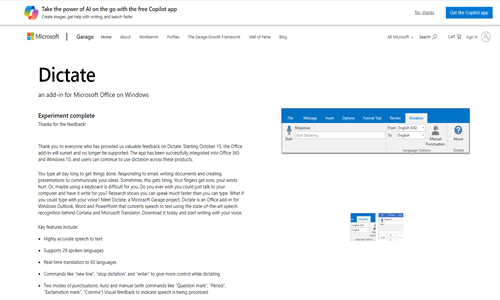
Microsoft Dictate is a voice-to-text plugin for Microsoft Office applications. It enables users to dictate text directly into documents and emails with high accuracy. It offers real-time transcription and supports multiple languages.
Pros:
Integration with Microsoft Office, real-time transcription, and multilingual support.
Cons:
Limited to Microsoft Office applications, may require additional setup.
Services Provided:
Real-time transcription integration with Office applications.
Pricing Package:
Available as a free plugin for Microsoft Office.
Otter.ai
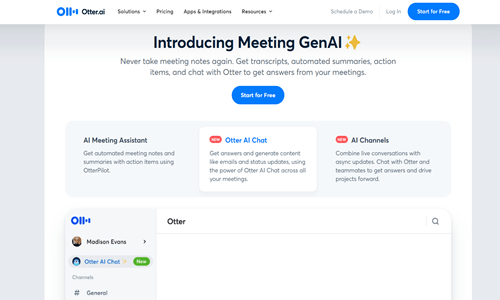
An AI-powered transcription service called Otter.ai provides precise and instantaneous text transcription of spoken words. It offers collaborative functions, speaker detection, and connection with well-known productivity applications.
Pros:
Accurate transcription, collaboration features, and integration options.
Cons:
Limited free tier may have usage limitations.
Services Provided:
Real-time transcription collaboration features.
Pricing Package:
A free tier with limited features and premium plans is available.
IBM Watson
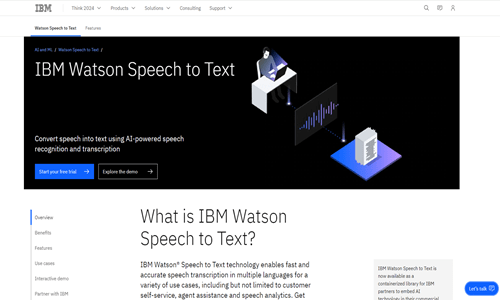
A cloud-based voice recognition service called IBM Watson Voice to Text accurately transcriptions audio files and live speech. It effortlessly connects with IBM’s spectrum of cognitive services and supports multiple languages.
Pros:
High accuracy, multilingual support, seamless integration.
Cons:
Technical expertise may be required to set pricing based on usage.
Services Provided:
Transcription of audio files, real-time speech recognition.
Pricing Package:
Pay-as-you-go pricing based on usage.
Speechmatics
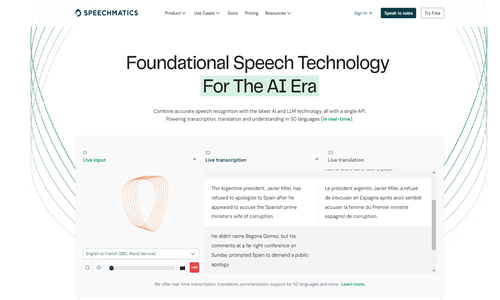
Speechmatics is a cloud-based speech recognition platform that accurately transcriptions audio files and live speech in multiple languages. It offers customizable language models, speaker diarization, and integration with third-party applications.
Pros:
Accurate transcription, customizable language models, and integration options.
Cons:
Pricing is based on usage and may require technical integration.
Services Provided:
Transcription of audio files, real-time speech recognition.
Pricing Package:
Pay-as-you-go pricing based on usage.
Amazon Transcribe
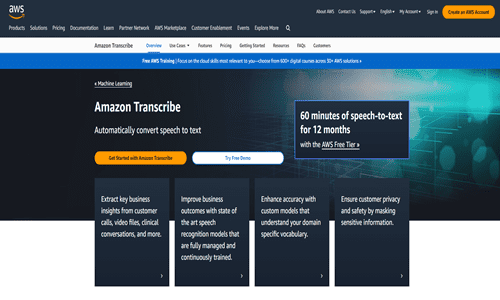
Amazon Transcribe is a speech-to-text service offered by Amazon Web Services (AWS) that accurately and automatically transcriptions audio files and live speech. It supports multiple languages and offers customizable vocabulary lists for domain-specific terminology.
Pros:
Accurate transcription, customizable vocabulary lists, and integration with AWS services.
Cons:
Pricing, based on usage, may require an AWS account.
Services Provided:
Transcription of audio files, real-time speech recognition.
Pricing Package:
Pay-as-you-go pricing based on usage.
Sonix

Sonix is an artificial intelligence-powered transcription service that quickly and accurately transcribes audio and video files. It also features speaker identification, sophisticated editing capabilities, and compatibility with well-known cloud storage providers.
Pros:
Fast and accurate transcription, advanced editing tools, and integration options.
Cons:
Pricing is based on usage, but usage limitations may be present.
Services Provided:
Transcription of audio and video files and editing tools.
Pricing Package:
Pay-as-you-go pricing based on usage.
Rev.ai
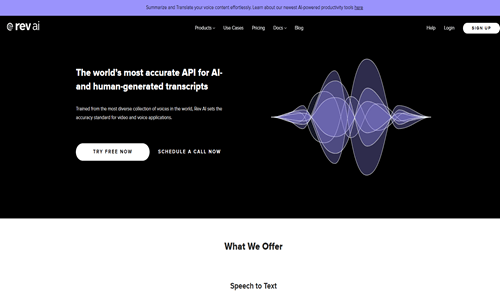
Rev.ai is a speech recognition API that offers accurate and scalable transcription services for developers and businesses. It provides real-time transcription and integration with third-party applications and platforms.
Pros:
Accurate transcription, real-time speech recognition, and integration options.
Cons:
Pricing is based on usage and may require technical integration.
Services Provided:
Transcription services for developers and businesses.
Pricing Package:
Pay-as-you-go pricing based on usage.
How to Choose the Right Voice-to-Text Software
When selecting a voice-to-text software solution, consider factors such as:
Choosing the right voice-to-text software requires careful consideration of several factors to ensure it meets your specific needs and preferences. Here’s a guide on how to choose the right voice-to-text software:
Accuracy and Reliability:
Look for software that offers high accuracy and reliability in transcribing spoken words into written text. Accuracy is crucial for ensuring that your transcriptions are error-free and usable for their intended purpose.
Language Support:
Consider the software’s language support, particularly if you need to transcribe content in languages other than English. Choose software that supports multiple languages and dialects to accommodate your linguistic needs.
Customization Options:
Examine the software’s customization features, including changing language models, transcription settings, and voice recognition sensitivity. These capabilities allow you to adjust the transcription experience to meet your needs and preferences.
Real-Time Transcription:
Determine if you require real-time transcription capabilities, where spoken words are instantly converted into written text as you speak. Real-time transcription is beneficial for tasks requiring immediate feedback or users who prefer to review their dictation as they speak.
Integration with Productivity Tools:
If you use productivity tools such as word processors, email clients, or note-taking apps, choose software that integrates seamlessly with these applications. Integration with productivity tools enhances workflow efficiency and simplifies transcribing and managing your text.
Compatibility Across Devices:
The software should work with various hardware and operating systems, such as desktop and laptop computers, tablets, and smartphones. Thanks to cross-device compatibility, you can transcribe text on any device, no matter where you are.
Ease of Use:
Consider the software’s user interface and usability, particularly if you’re unfamiliar with voice-to-text technologies. Look for easy-to-use interface and navigation software to reduce learning curves and increase usability.
Security and Privacy:
Select software that highly values security and privacy to safeguard your private voice recordings and transcribed text against illegal access or data breaches. Pay attention to features like end-to-end encryption and adherence to data security laws.
Customer Support:
Examine the degree of technical assistance, documentation, and user resources the software provider offers as part of their customer service. Select software that provides prompt customer service to answer any questions or concerns you may have during installation and use.
Pricing and Value:
Lastly, consider the pricing structure and value proposition offered by the software. Compare pricing plans, features, and benefits to determine which option provides the best value for your budget and requirements.
Tips for Improving Accuracy with Voice-to-Text Software
Improving accuracy with voice-to-text software is essential for obtaining reliable transcriptions. Here are some tips to enhance accuracy:
Speak Clearly and Slowly:
Talk slowly and clearly to ensure the software correctly detects and transcribes your speech.
Minimize Background Noise:
Try to minimize surrounding noise so the software can concentrate on properly recording your speech. Dictate in a peaceful setting to reduce interruptions and distractions.
Use Proper Pronunciation:
Pronounce words correctly and avoid mumbling or slurring your speech, as this can lead to errors in transcription. Pay attention to pronunciation, especially for complex or unfamiliar words.
Articulate Punctuation:
AArticulate punctuation marks such as commas, periods, and question marks to help the software accurately punctuate your transcriptions. Use natural pauses to indicate punctuation in your speech.
Provide Context and Clarity:
Clearly state the subject or topic of your dictation to provide context and clarity. This helps the software understand the meaning of your words and improves accuracy in transcribing specialized terminology or jargon.
Review and Edit Transcriptions:
Once your speech has been transcribed, proofread the text to ensure correctness and make any required changes. Even while voice-to-text software is extremely precise, there are situations where it misinterprets words or phrases, particularly in situations that are unclear or complex.
Train the Software:
Users can train certain voice-to-text programs to identify their speech patterns and voices better. Use the software’s training functions to increase accuracy over time.
Use Custom Vocabulary Lists:
If the software supports it, create custom vocabulary lists containing specialized terms, acronyms, or industry-specific terminology relevant to your speech. Custom vocabulary lists help the software recognize and transcribe these terms accurately.
Optimize Settings and Preferences:
Adjust the software’s settings and preferences to optimize your voice and speech style performance. Explore options such as voice recognition sensitivity, transcription speed, and language models to find your best settings.
Practice Regularly:
Practice dictation regularly to become more comfortable and proficient with voice-to-text software. With practice, you’ll develop better speech habits and improve accuracy in transcribing your speech.
Voice to Text Software for Different Platforms
Voice-to-text software is available for various platforms, allowing users to transcribe their speech into text on different devices. Here are some popular options for different platforms:
Windows:
Dragon NaturallySpeaking:
A leading voice recognition software for Windows that offers high accuracy and advanced customization options.
A voice-to-text plugin for Microsoft Office applications, allowing users to dictate text directly into Word, Outlook, and other Office programs.
macOS:
Built-in voice-to-text functionality on macOS devices, providing accurate transcription of spoken words into text in various applications.
Dragon for Mac:
A version of Dragon NaturallySpeaking specifically designed for macOS offers features and functionality similar to its Windows counterpart.
Android:
Google Keyboard (Gboard):
The default Android keyboard app offers voice typing functionality for transcribing speech into text in any text field.
Google Assistant:
A built-in virtual assistant on Android devices that can transcribe spoken words into text in various apps and services.
iOS:
Siri:
Apple’s virtual assistant for iOS devices offers voice recognition and transcription capabilities for dictating text messages, emails, notes, and more.
Voice Memos:
A built-in app on iOS devices that allows users to record audio and transcribe spoken words into text using the speech-to-text feature.
Web-based:
Otter.ai:
A cloud-based transcription service accessible via a web browser, offering real-time transcription of meetings, interviews, and other audio recordings.
Google Docs Voice Typing:
A feature within Google Docs that allows users to dictate text directly into documents using their web browser, with accurate transcription and real-time feedback.
Voice-to-Text Software for Specific Industries
Voice-to-text software is invaluable across various industries, aiding in transcription, note-taking, and communication. Here are examples of voice-to-text software tailored for specific industries:
Legal Industry:
Dragon Legal:
They are designed for legal professionals, offering accurate transcription and specialized legal vocabulary recognition.
Temi Legal:
Provides legal transcription services with high accuracy and confidentiality for law firms, courts, and legal departments.
Medical Industry:
Dragon Medical Practice Edition:
They are tailored for healthcare professionals, offering specialized medical vocabulary recognition and HIPAA-compliant transcription.
M*Modal:
Provides medical transcription and speech understanding solutions for hospitals, clinics, and healthcare organizations.
Education Industry:
Speech notes:
Ideal for educators and students, offering easy-to-use voice recognition for note-taking, lectures, and presentations.
Voice Dream Reader:
With text-to-speech and voice recognition capabilities, it is intended for kids with dyslexia and other learning impairments.
Journalism Industry:
Descript:
Allows journalists to transcribe interviews, record audio, and edit transcripts collaboratively with team members.
Happy Scribe:
Offers accurate transcription services for journalists, bloggers, and media professionals with fast turnaround times.
Business Industry:
Rev:
Provides transcription services for business meetings, interviews, and conferences, offering high accuracy and quick turnaround.
Trint:
Enables businesses to transcribe audio and video recordings, with features for editing, collaboration, and sharing transcripts.
Entertainment Industry:
Sonix:
Ideal for filmmakers and content creators, offering transcription and translation services for video and audio recordings.
Descript:
Podcasters and audio producers use them to transcribe podcasts, edit audio files, and create show notes.
Research Industry:
Otter.ai:
Popular among researchers and academics for transcribing interviews, lectures, and research discussions with real-time collaboration features.
Temi:
Provides affordable transcription services for academic research, focus groups, and qualitative data analysis.
Current Trends in voice-to-text-software
Current trends in voice-to-text software reflect advancements in technology and changing user preferences. Here are some notable trends:
Improved Accuracy with AI:
Voice-to-text software leverages artificial intelligence (AI) and machine learning (ML) algorithms to enhance transcription accuracy. AI-driven models continuously learn from user input, resulting in more accurate and contextually relevant transcriptions.
Real-Time Transcription:
There is a growing demand for real-time transcription capabilities, particularly in healthcare, legal, and media industries. Real-time transcription allows users to capture spoken words instantly, enabling faster communication and decision-making.
Multilingual Support:
Voice-to-text software progressively supports many languages and dialects to serve a global user base. In various linguistic contexts, sophisticated language models and natural language processing (NLP) methods make precise transcription possible.
Customization and Personalization:
Users seek voice-to-text software that offers customization and personalization options to meet their needs and preferences. Customizable language models, vocabulary lists, and user profiles enhance transcription accuracy and user experience.
Mobile Accessibility:
With the increasing use of smartphones and tablets, voice-to-text software focuses on mobile accessibility and optimization. Mobile apps offer on-the-go transcription capabilities, enabling users to dictate text anytime, anywhere, using their mobile devices.
Security and Privacy Features:
Voice-to-text software providers have responded to privacy and data security concerns by incorporating strong security features such as data anonymization, end-to-end encryption, and adherence to data protection laws. Protecting the privacy of sensitive information is of the utmost importance for both consumers and companies.
Voice Command Integration:
With the integration of voice command functionality, speech-to-text software enables users to use voice commands for activities including text formatting, punctuation, and document navigation. This integration increases user accessibility and promotes hands-free operation.
Accessibility Features:
Software for voice-to-text includes accessibility capabilities to help people with disabilities, such as vision or mobility limitations. Thanks to text-to-speech features, voice navigation, and assistive technology compatibility, all users are guaranteed inclusivity and accessibility.
Cloud-Based Solutions:
Cloud-based voice-to-text solutions are gaining popularity due to their scalability, flexibility, and accessibility. These platforms offer seamless synchronization across devices, automatic updates, and collaborative features, making them ideal for remote work and distributed teams.
Challenges and Limitations of Voice-to-Text Software
Despite its many benefits, voice-to-text software also faces several challenges and limitations:
Accuracy Issues:
Accuracy is one of the main issues with voice-to-text technologies. Even with the improvements in AI and ML, the software may still need help effectively transcribing speech, particularly in noisy situations or when there are accents, dialects, or specialist languages.
Contextual Understanding:
Voice-to-text software may struggle to capture spoken words’ context accurately, leading to transcription errors. The software may also struggle to understand nuances such as tone, sarcasm, or ambiguity, resulting in inaccuracies or misinterpretations.
Language and Accent Limitations:
Voice-to-text software may only support some languages or dialects equally, leading to limitations for users who speak languages other than the dominant ones supported by the software. Accents and regional variations in pronunciation can also pose challenges for accurate transcription.
Privacy Concerns:
Privacy is a significant concern with voice-to-text software, as it captures and processes users’ spoken words. Due to concerns about data privacy and security breaches, users may be wary of sharing sensitive or confidential information with voice-to-text software.
Training and Customization:
Voice-to-text software frequently needs Training and customization to increase accuracy and adjust to each user’s unique speech patterns. However, training the software can be a time-consuming procedure that only sometimes produces acceptable outcomes.
Integration and Compatibility:
Integrating voice-to-text software with existing applications, platforms, or devices can be challenging, especially if compatibility issues arise. Users may need help seamlessly incorporating voice transcription into their existing workflows or technology stack.
Technical Limitations:
Voice-to-text software may have technical limitations regarding processing power, network connectivity, or device compatibility. Users may experience lag or delays in transcription, particularly when dealing with large volumes of speech data or real-time transcription requirements.
Lack of User Awareness and Training:
Some users may need to be made aware of the capabilities or limitations of voice-to-text software, leading to unrealistic expectations or frustration with its performance. Adequate user awareness and training are essential for maximizing the benefits of voice-to-text software and mitigating challenges.
Environmental Factors:
Environmental factors such as ambient conditions, background noise, and microphone quality can impact voice-to-text software performance. In difficult circumstances, users must use external devices or adjust their surroundings to increase transcription accuracy.
Legal and Regulatory Compliance:
Voice-to-text software must comply with legal and regulatory standards regarding data protection, security, and accessibility. Ensuring adherence to pertinent rules and regulations can be difficult for users and software developers.
Security and Privacy Considerations with Voice-to-Text Software
Security and privacy concerns are crucial when using voice-to-text software because spoken information is sensitive. Here are some crucial things to remember:
Data Encryption:
Voice-to-text software should use strong encryption mechanisms to safeguard data while it is being transferred and stored, avoiding unwanted access or interception. With end-to-end encryption, voice data is encrypted before transmission and only decryptable by authorized recipients.
User Consent and Transparency:
It is important to let users know how the software will gather, use, and keep their speech data. Users should have access to transparent privacy rules and consent methods to understand and approve using their speech data for transcription.
Anonymization and De-identification:
Voice-to-text software should anonymize or de-identify voice data to remove personally identifiable information (PII) and protect user privacy. Anonymized data helps mitigate privacy risks by preventing the identification of individual users based on their voice recordings.
Data Minimization:
Voice-to-text software should only collect and retain voice data necessary for transcription purposes. Minimizing the collection of unnecessary data reduces the risk of privacy breaches and enhances data protection.
Access Controls:
Only authorized individuals should be able to access voice data; even then, tight access restrictions should be in place to safeguard it. Strong password restrictions, multi-factor authentication (MFA), and role-based access control (RBAC) all help prevent unwanted access to private voice data.
Secure Storage and Transmission:
Voice-to-text software should use safe storage methods and encrypted protocols to transfer and preserve voice data. Secure storage solutions, such as encrypted databases, and secure transmission protocols, like HTTPS, protect voice data from unauthorized access during storage and transmission.
Compliance with Regulations:
Software that converts voice to textual content must abide by relevant privacy legal guidelines and tips, including the US Health Insurance Portability and Accountability Act (HIPAA) and the General Data Protection Regulation (GDPR) in Europe. Adherence to legislation guarantees the responsible and moral handling of voice users’ privacy and customers’ privacy rights.
Data Retention Policies:
Voice-to-text software should have explicit data retention policies that outline how long voice data will be kept on file and when it will be erased. Implementing these policies may reduce privacy concerns and guarantee that you follow all applicable laws.
Third-Party Audits and Certifications:
Voice-to-text software providers should undergo third-party audits and obtain certifications to demonstrate compliance with privacy and security standards. Certifications such as ISO 27001 or SOC 2 ensure the software meets stringent security and privacy requirements.
User Empowerment:
Voice-to-text software should empower users to control their privacy settings, manage their voice data, and exercise their privacy rights. Allowing users to delete voice recordings, adjust privacy settings, and opt out of data collection enhances transparency and trust.
Integrating Voice-to-Text Software into Your Workflow
Integrating voice-to-text software into your workflow can streamline communication, improve productivity, and enhance accessibility. Here are steps to effectively integrate voice-to-text software into your workflow:
Assess Your Needs:
Identify areas of your workflow where voice-to-text software can be beneficial. Determine tasks that involve transcription, note-taking, documentation, or communication where speech-to-text technology can save time and effort.
Choose the Right Software:
Research and select a voice-to-text software solution that aligns with your workflow requirements, preferences, and budget. Consider factors such as accuracy, language support, compatibility with devices and platforms, and security features.
Install and Configure:
Install the voice-to-text app of your choice on your devices or use online resources to access it. Follow the setup instructions to customize the software, including language options, voice recognition training, and privacy settings.
Training and Familiarization:
Introduce the voice-to-text software’s features and functionalities to yourself and your team. Utilize the training materials offered by the program provider to gain proficiency with speech recognition, commands, and editing tools.
Integrate with Existing Tools:
Integrate voice-to-text software with your existing tools and applications to streamline your workflow. To enhance interoperability and efficiency, look for integrations with productivity suites, email clients, note-taking apps, project management tools, and collaboration platforms.
Practice and Experiment:
Practice using voice-to-text software in different scenarios and experiment with its capabilities. Explore voice commands, punctuation shortcuts, formatting options, and editing tools to optimize your transcription workflow and maximize productivity.
Feedback and Iteration:
Solicit feedback from users and stakeholders about their experience with the voice-to-text software. Gather insights about usability, accuracy, and performance to identify areas for improvement and optimization. Iterate your workflow based on feedback to enhance efficiency and effectiveness.
Security and Compliance:
Ensure that voice-to-text software conforms to your company’s security and privacy rules. Implement sensitive information protection measures to reduce privacy concerns and guarantee regulatory compliance. Examples of these include encryption, access limits, and data anonymization.
Monitor and Evaluate:
Track the effectiveness and long-term effects of voice-to-text technologies on your productivity. Analyze measures like user happiness, time saved, and transcribing accuracy to determine how beneficial the integration is. As necessary, make changes to maximize output and user satisfaction.
Continuous Learning and Improvement:
Stay informed about voice-to-text software updates, enhancements, and best practices. Engage in continuous learning to leverage new features, improve accuracy, and explore innovative ways to effectively integrate speech recognition technology into your workflow.
FAQs
Is voice-to-text software accurate, especially with different accents and languages?
Voice-to-text software accuracy can vary, but technological advancements have significantly improved accuracy rates. Most software now supports various accents and languages, although some may perform better than others based on training data and algorithms.
Can voice-to-text software transcribe multiple speakers in a conversation?
Indeed, many voice-to-text programs can record and transcribe multi-speaker discussions. However, several variables could affect accuracy, including background noise, speaker clarity, and the software’s capacity to discern distinct speakers.
Are voice recordings stored and processed securely by the software?
Reputable voice-to-text software providers prioritize user privacy and security. They typically employ encryption, access controls, and data anonymization techniques to protect voice recordings and ensure compliance with privacy regulations.
Can voice-to-text software be used for sensitive or confidential information?
While voice-to-text software is convenient for transcribing various types of content, it’s essential to exercise caution when using it for sensitive or confidential information. Users should review the software’s privacy policies and consider additional security measures to safeguard sensitive data.
Does voice-to-text software require an internet connection to function?
It depends on the specific software. Some voice-to-text solutions operate offline, while others require an internet connection for features like cloud-based processing, language recognition, and real-time transcription. Users should check the software’s requirements for offline functionality.
How can I improve accuracy when using voice-to-text software?
To improve accuracy, speak clearly and enunciate words, minimize background noise, and ensure a high-quality microphone. Additionally, consider training the software to recognize your voice better and proofread transcriptions for errors to provide feedback and improve performance over time.
Conclusion
Voice-to-text software programs have improved accessibility, performance, and productivity in various fields and applications. This creative solution will help customers effortlessly translate spoken phrases into written text by utilizing contemporary speech reputation generation, streamlining approaches, and increasing productivity. With the non-stop advancements in artificial intelligence and natural language processing, the destiny of voice-to-text software seems even more promising, supplying more desirable accuracy, multilingual competencies, and seamless integration with other technology. By investigating the quality voice-to-text software option, you can remodel your paintings and attain your complete capacity as a creator, student, or business expert.




